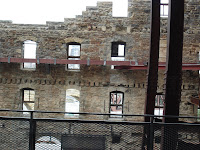

Here's a little history on the Mill itself taken from their website:
Beginning in 1880 and for 50 years thereafter, Minneapolis was known as the “Flour Milling Capital of the World” and more informally, as the “Mill City.”
The city grew up around the mills. In 1870, the city’s population was 13,000. Twenty years later, it had grown to nearly 165,000.
Grain came in via rail lines that stretched across the Northern Plains grain belt into the Dakotas and Canada. Trains also carried the milled flour to Duluth and to eastern U.S. destinations both for export and domestic distribution.
After World War I, the milling industry in Minneapolis began to decline. As the industry moved out of Minneapolis, the old mills fell into disuse. The Washburn A Mill closed in 1965 and was nearly destroyed by fire in 1991. Its ruins were incorporated into the Mill City Museum.
At the time the mill was the largest and most technologically advanced mill in the world, featuring new automatic steel rollers instead of traditional millstones. During its heyday, it was said that the mill ground enough flour to make 12 million loaves of bread a day.
Two different types of millstones


A large Bisquick sign
 Did you know that the cereal Wheaties was actually made by accident? Someone spilled a little wheat bran mixture onto a hot stove and thought it tasted pretty good. So, after several attempts at perfecting the cereal - Wheaties was developed.
Did you know that the cereal Wheaties was actually made by accident? Someone spilled a little wheat bran mixture onto a hot stove and thought it tasted pretty good. So, after several attempts at perfecting the cereal - Wheaties was developed.

The best part of the museum is the multi-story Flour Tower, in which visitors sit in the cab of a freight elevator and are taken to different floors of the building, each designed to look like a floor in a working flour mill.

Here are a few pictures of the different floors of the building - the pictures didn't turn out the greatest because we weren't allowed to use a flash.

 There were actually two fires in this mill - one in 1878 and another one in 1991.
There were actually two fires in this mill - one in 1878 and another one in 1991.
On May 2, 1878, a spark ignited airborne flour dust within the mill, creating an explosion that demolished the Washburn A and killed 14 workers instantly. The ensuing fire resulted in the deaths of four more people, destroyed five other mills, and reduced Minneapolis’s milling capacity by one third. Known as the Great Mill Disaster, the explosion made national news and served as a focal point that led to reforms in the milling industry. In order to prevent the buildup of combustible flour dust, ventilation systems and other precautionary devices were installed in mills throughout the country. (Wikipedia)
These are the only pieces of equipment that survived the fires.


 From the 9th floor of the Mill, there were amazing views of the Mississippi River and St. Anthony Falls.
From the 9th floor of the Mill, there were amazing views of the Mississippi River and St. Anthony Falls.
 Amaya and Steve
Amaya and Steve
 It was amazing to see how much destruction the fires caused.
It was amazing to see how much destruction the fires caused.
 After the Flour Tower tour, we went back to the interactive exhibits and learned about the power and force of water.
After the Flour Tower tour, we went back to the interactive exhibits and learned about the power and force of water.


 We also went to the Baking Lab to try a sample of bread and there was a small station set up for kids to play with playdough.
We also went to the Baking Lab to try a sample of bread and there was a small station set up for kids to play with playdough.

 All the different types of flour.
All the different types of flour.

Here are some replicas of the type of equipment that was used in the mill in the 1880s.
This is a middlings purifier used to remove the husks from the kernels of wheat.
 A dust collector used to prevent the buildup of combustible flour dust.
A dust collector used to prevent the buildup of combustible flour dust.
 A roller mill used to grind the grain.
A roller mill used to grind the grain.
 We continued the tour outside to the Charles H. Bell Ruin Courtyard.
We continued the tour outside to the Charles H. Bell Ruin Courtyard.
 Again, we were amazed at the destruction.
Again, we were amazed at the destruction.

 Then we went across the street to walk along the Mississippi River to see the Mill Ruins Park and get a closer view of St. Anthony Falls.
Then we went across the street to walk along the Mississippi River to see the Mill Ruins Park and get a closer view of St. Anthony Falls.


 Who knew a flour museum could be so interesting?
Who knew a flour museum could be so interesting?




